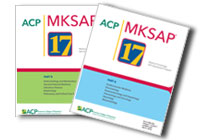 MKSAP has been trusted by internists since 1967 as the best resource for updating knowledge. MKSAP 17, available in Complete, Digital, and Print packages, consists of 11 comprehensive text chapters with related multiple-choice questions. You'll find 1,200 completely new questions to help you identify learning gaps, stay current, and gain the knowledge you need to provide the best possible patient care. MKSAP 17's original and high-quality questions evolve out of case studies and patient scenarios based on the latest evidence.
MKSAP has been trusted by internists since 1967 as the best resource for updating knowledge. MKSAP 17, available in Complete, Digital, and Print packages, consists of 11 comprehensive text chapters with related multiple-choice questions. You'll find 1,200 completely new questions to help you identify learning gaps, stay current, and gain the knowledge you need to provide the best possible patient care. MKSAP 17's original and high-quality questions evolve out of case studies and patient scenarios based on the latest evidence.
For more information on MKSAP 17, or to order your copy, visit mksap17.acponline.org.
MKSAP 17 Q&A
A 59-year-old man is evaluated in the emergency department for an episode of syncope. He experienced lightheadedness upon arising from a chair, which was followed by a witnessed transient loss of consciousness. He was immediately arousable and alert within 10 seconds. There was no loss of bladder or bowel function. He was otherwise asymptomatic prior to the event. Medical history is significant for hypertension and poorly controlled type 2 diabetes mellitus. Medications are benazepril, insulin glargine, and rosuvastatin.
On physical examination, the patient is afebrile. Blood pressure is 147/72 mm Hg supine and 120/76 mm Hg standing, pulse rate is 72/min supine and 94/min standing, and respiration rate is 14/min. BMI is 27. There is no jugular venous distention. Cardiopulmonary and abdominal examinations are normal. On neurologic examination, he is alert and oriented. Neurologic examination is unremarkable except for decreased sensation to touch in the feet bilaterally.
Laboratory studies are significant for a plasma glucose level of 338 mg/dL (18.8 mmol/L).
A 12-lead electrocardiogram shows normal sinus rhythm with normal axis and intervals and no acute ST- or T-wave changes.
Which of the following is the most likely cause of this patient's syncope?
A: Orthostatic hypotension
B: Seizure
C: Silent cardiac ischemia
D: Ventricular arrhythmia
Back to the November 2017 issue of ACP International

